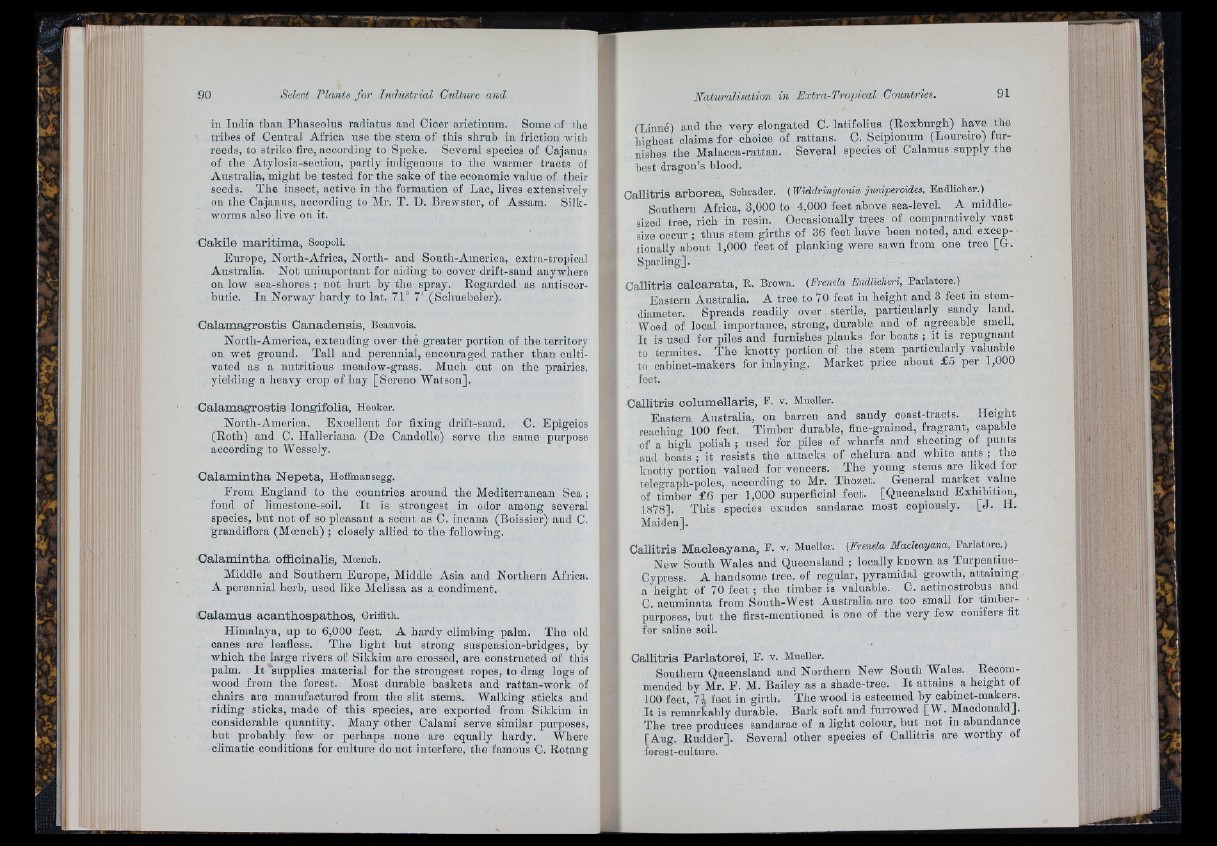
in India than Phaseolus radiatus and Cicer arietinnm. Some of the
tribes of Central Africa nse the stem of this shrub in friction -vvitli
reeds, to strike fire, according to Speke. Several species of Cajamis
of the Atylosia-section, partly indigenous to the warmer tracts of
Australia, miglit be tested for tlie sake of tlie economic value of their
seeds. The insect, active in the formation of Lac, lives extensively
on the Cajanns, according to Mr. T. Ü. Brewster, of Assam. Silkworms
also live on it.
C a k ile m a r i t im a , Scopoli.
Europe, North-Africa, North- and South-America, extra-tropical
Australia. Not unimportant for aiding to cover drift-sand anywhere
on low sea-shores ; not hurt by the spray. Regarded as antiscorbutic.
In Norway hardy to lat. 71° 7' (Schuebeler).
C a lam a g r o s t i s C a n a d e n s i s , Beauvois.
North-America, extending over tlie greater portion of the territory
on wet ground. Tall and perennial, encouraged rather than cultivated
as a nutritious meadow-grass. Much cut on the prairies,
yielding a heavy crop of liay [Sereno Watson].
C a lam a g r o s t i s lo n g ifo lia , Hooker.
North-America. Excellent for fixing drift-sand. C. Epigeios
(Roth) and C. Halleriana (De Candolle) serve the same purpose
aecording to Wessely.
C a l a m in t h a N e p e t a , Hoffmansegg.
From England to the countries aromid the Mediterranean Sea ;
fond of limestoiie-soil. I t is strongest in odor among several
species, but not of so pleasant a scent as C. incana (Boissier) and C.
grandiflora (Moench) ; closely allied to the following.
C a l a m in th a o fflc in a lis , Moenoh.
Middle and Soutliern Europe, Middle Asia and Northern Africa.
A perennial herb, used like Melissa as a condiment.
C a l a m u s a c a n th o s p a th o s , Griffith.
Himalaya, up to 6,000 feet. A hardy climbing palm. The old
canes are leafless. The light but strong suspension-bridges, by
which the large rivers of Sikkim are crossed, are constructed of this
palm. I t supplies material for the strongest ropes, to drag logs of
wood from the forest. Most durable baskets and rattan-work of
chairs are manufactured from the slit stems. Walking sticks and
riding sticks, made of this species, are exported from Sikkim in
considerable quantity. Many other Calami serve similar purposes,
but probably few or perhaps none are equally hardy. Where
climatic conditions for culture do not interfere, the famous C. Rotang
(Linné) and the very elongated C. latifolius (Roxburgh) have the
highest claims for choice of rattans. C. Scipionum (Loureiro) fur-
niSies the Malacca-rattan. Several species of Calamus supply the
best dragon’s blood.
C a llitris a r b ó r e a , Schrader. (Widdringtmia juniperoides, Endlicher.)
Southern Africa, 3,000 to 4,000 feet above sea-level. A middle-
sized tree, rich in resin. Occasionally trees of comparatively vast
size occur ; thus stem girths of 36 feet have been noted, and excep-
fionally about 1,000 feet of planking were sawn from one tree [G.
Sparling].
C a llitris c a l c a r a t a , R. Brown. (Preuela Endlicheri, Parlatore.)
Eastern Australia. A tree to 70 feet in height aud 3 feet in stem-
diameter. Spreads readily over , sterile, partioularly sandy land.
Wood of local importance, strong, durable and of agreeable smell.
It is used for piles and furnishes planks for boats ; it is repugnant
to termites. The knotty portion of the stem particularly valuable
to cabinet-makers for inlaying. Market price about £5 per 1,000
feet.
C a llitr is c o lum e lla r is , P. v. Mueller.
Eastern Australia, on barren and sandy coast-tracts. Height
reaching 100 feet. Timber durable, fine-grained, fragrant, capable
of a high polish ; used for piles of wharfs and sheeting of punts
and boats ; it resists the attacks of chelura and white ants ; the
knotty portion valued for veneers. The young stems are liked for
telegraph-poles, according to Mr. Thozet. General market value
of timber £6 per 1,000 superficial feet. [Queensland Exhibition,
1878]. This species exudes sandarac most copiously. [ J . H.
Maiden].
C a llitr is M a c le a y a n a , E. V. Mueller. (Frenda Madtayana, Parlatore.)
New South Wales and Queensland ; locally known as-Turpentiiie-
CypresB. A handsome tree, of regular, pyramidal growth, attaining
a height of 70 feet ; the timber is valuable. C. actinostrobus and
C. acuminata from South-West Australia are too small for timber-
pnrposes, but the first-mentioned is one of the very few conifers fit
for saline soil.
C a llitr is P a r l a to r e i , E. v. Mueller.
Southern Queensland and Northern New South Wales. Recommended
by Mr. F. M. Bailey as a shade-tree. I t attains a height of
100 feet, 7ir feet in girth. The wood is esteemed by cabinet-makers.
It is remarkably durable. Bark soft and furrowed [W. Macdonald].
The tree produces sandarac of a light colour, but not m abundance
[Aug. Rudder]. Several other species of Callitris are worthy of
forest-oultiire.
fri;